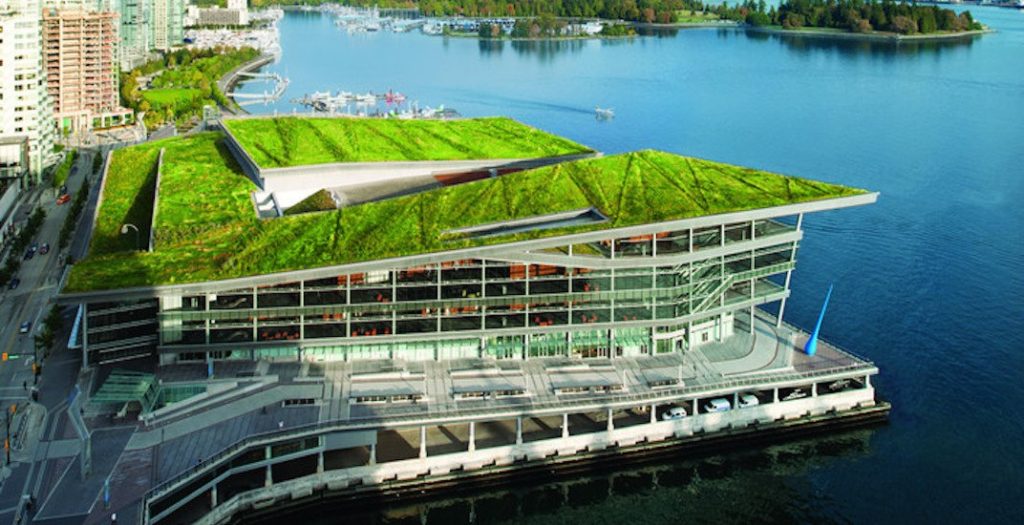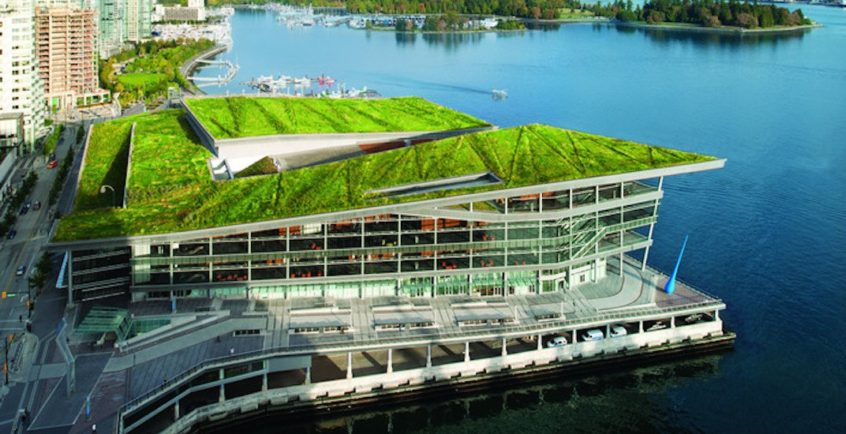By Esprit Farmer
Nature-Based Solutions (NBS) are innovative actions that focus on adopting natural practices to help create greener cities, mitigate the effects of climate change, and increase biodiversity. NBS draws from functional elements of ecosystems and applies them to unnatural settings such as buildings and cities. Incorporating nature into urban settings have wide-spread positive impacts on biodiversity, energy consumption, mental health, and more.
NBS recognizes the tools that can be gained from nature and adapted to how we live, such as the use of drought-resistant plants, biodiversity, and renewable energy. These solutions can take many forms, from sustainable farming practices to carbon-neutral buildings.
NBS also offers a solution to global issues such as climate change by using natural areas as a means to sequester carbon. In doing so, it provides protection and rehabilitation to natural habitats such as wetlands and forests that are important carbon sinks.
The focus of NBS is on creating a sustainable system. Nature is run by interconnected pieces that work together to flourish. By attempting to incorporate elements from these systems, we can create a resilient, functioning ecosystem.
Where are Nature-Based Solutions applied?
Cities
Because of their large population, cities pose many planning and environmental challenges. Almost 70% of all people live in cities, which means that healthy cities could dramatically decrease our carbon footprint. NBS focuses on achieving this both through building design and incorporating nature.
Of course, these two elements go hand-in-hand. Buildings such as the Vancouver Convention Centre incorporate natural elements to increase shade, cool the building, and increase oxygen. This can be done through green roofs; sun-tolerant plants absorb heat and keep the building cool, reducing the need for air conditioning. The plants also absorb carbon dioxide from the air, cleaning the city!
This design is also beneficial for water runoff. Cities often flood because concrete stops water from entering the soil, but green roofs help to absorb this water.



In order to maximise a green roof’s benefit, it is important to pair the plants with the surrounding habitat. Xerophytic plants (low-water plants like cacti and succulents) are best for hot climates because they take less water and can handle direct sun.
Many cities have also begun to integrate natural habitats into their cities. This is seen in Rotterdam, where the city’s runoff water is stored in a wetland. Surrounded by natural grasses and native plants, their water storage doubles while feeding an important ecosystem.
As a result, the water is filtered before leaving the city or being reused, and floods are mitigated because the wetland can hold a larger amount of water. The wetland is also accessible to the public by way of boardwalks and bike paths, creating green space for citizens.
Nature plays a valuable part in our lives and it can be inaccessible to those who live in cities. This illustrates the importance of nature-based solutions: by incorporating nature into our cities, it not only helps to save the environment, but it also brings nature to those who aren’t able to access it as easily.
Forests and Wetlands
Depending on the type and age, on average, one mature tree can absorb around 48 pounds of carbon dioxide a year, while releasing oxygen in the process. Many argue that trees present an important key to ending climate change. This has prompted tree-planting efforts worldwide as a nature-based solution.
Wetlands, on the other hand, are equally important. Covering an estimated 140,000 km2, mangroves act as incredibly important ecosystems, providing habitat for people and animals alike. They also have a massive environmental impact. IUCN explains the benefits:
“In Senegal, the world’s largest mangrove reforestation project led investors to generate half a million tonnes of carbon offsets over its 30-year lifetime. In addition, the delta now protects arable land from salt contamination, rice paddies are restored, and fish stocks replenished by up to 18,000 additional tonnes per year.”
IUCN explains the ecological and economical benefits from nature-based solutions.



This is the gift of nature-based solutions: on top of strengthening the ecosystem, they solve many intertwined problems for both the environment and people.
Closer to home, nature-based solutions can be seen in Canada’s boreal forest. Modern forestry practices often emulate natural disturbance patterns. This involves leaving large swaths of undisturbed forest and harvesting cut-blocks in irregular shapes which allows vegetation to regrow as it would following a natural disturbance.
This method is a form of a nature-based solution because it imitates a natural system that benefits the ecosystem.
Grasslands
It may be surprising to learn that grasslands act as a massive carbon sink. In fact, soil contains more carbon than plants and animals combined. This makes Saskatchewan’s grassland ecosystem especially important.
The consequences of climate change on grasslands are dire. As global temperatures increase, grasslands are more susceptible to drought and forest fires. This creates a positive feedback loop: the effects of climate change, such as an increase in droughts and fires, lead to an increase in atmospheric carbon, which further intensifies the effects of climate change.
This shows the importance of climate solutions that focus on tackling carbon emissions: by reducing our emissions and sequestering carbon, we reduce the damage done by climate change, and hopefully halt the cycle.
A key tool of NBS is attempting to restore land to its natural state, or to how it was before it was degraded. Part of this is re-integrating species that have been removed from an ecosystem.
This is the case with bison: once dominating the plains, their species were almost completely wiped out in the late 1800s. This had a massive ecological impact on the grasslands and had a long-lasting detriment on Indigenous people in Canada.
The remediation of Saskatchewan’s grasslands is not possible without the rehabilitation of bison because of their integral natural and cultural ties. Reintegrating bison not only increases biodiversity, but bison are indirectly important for carbon sequestration. They aerate the land, spread seeds as they migrate, and fertilize the soil as they urinate and defecate. Find out more here to learn what CPAWS-SK is doing.



As seen in Saskatchewan, grasslands are ideal for farmland. This poses a challenge to conservation, because while grasslands are important, farmland is also vital for food and the economy. Because of this, a compromise must be reached that is both sustainable and productive.
Sustainable farming focuses on enriching the soil and water, with higher yield coming as a secondary benefit. It is argued that if done properly, cattle pastures can continue to successfully sequester carbon.
This involves planting grasses that are native to the area and that sequester carbon. As well, nitrogen-fixing legumes such as clover improve the soil and are good for cows. This also reduces the amount of water that is needed to irrigate the soil. NBS allows for a balance between human needs and ecological necessities.
Oceans
As the earth’s largest habitat, our planet would not be the same without oceans. They are responsible for regulating temperatures, powering our aquatic systems, and more. They have a global impact, and because of this, damage to oceans is felt everywhere.
Unfortunately, our oceans are at risk. This is directly due to human actions such as overfishing and dumping waste, and also climate change. Increasing temperatures and ocean acidification directly put 25% of the ocean’s fish at risk because of its damage to coral reefs, affecting all other kinds of aquatic life in some way. Increased habitat loss, food shortages, and chemicals endanger this precious ecosystem.
This volatility is also damaging to people. Sea-level rise is accelerating, and coupled with more intense storms, many coastal communities are left in vulnerable situations. Erosion and flooding damages farmland and cities alike, and many rely on fishing for a livelihood.
There are many nature-based solutions to both of these issues. Along coasts suffering from sea level rise and erosion, native trees are planted on the shore to keep the soil intact and act as a barrier. It is also important to foster healthy marine ecosystems like coral reefs. This can be done by introducing endangered fish species. As well, planting sea kelp strengthens biodiversity, increases habitat, and filters the water.
Rivers
While only 0.6% of water on earth is fresh and accessible, it is enough to support all forms of life. In Canada, we are lucky to hold 7% of the world’s freshwater. Even though we can physically see the abundance of water from our lakes, streams and rivers, our water is not unlimited.
In Saskatchewan, and indeed around the world, flowing water is vital to our modern-day operations. Beyond providing drinking water to many major cities, our rivers also fuel energy production and our food systems. Powered by 69 hydroelectric dams, 14% of Saskatchewan’s energy comes from our Saskatchewan rivers. We also need our river for food and the economy: 60% of water used in SK goes to farm irrigation. This is a massive amount of water, and without it, much of our land would not be arable.
While rivers provide many wonderful gifts, they are not boundless. There is the consideration of using too much water, and also of the quality of the water after we’ve used it. In a province relying heavily on non-renewable fossil fuels, hydroelectric power is a welcome renewable resource.
However, hydroelectric dams are not perfect, as they can have massive ecological and social impacts. They alter flow levels causing flood and drainage issues which can greatly disrupt animal habitats in the water and onshore. Dams will also block necessary sediments and nutrients that are needed downstream.
Irrigation has a massive impact on the operations and biodiversity of rivers. Firstly, diverting massive amounts of water will decrease the water levels downstream which increases dieback and erosion. As well, there is the impact of the used water that is reverted to the river, both intentionally and through groundwater and runoff.
Conventional farming techniques employ the use of pesticides and minerals, for example, phosphate, to increase crop yield. These upset the natural balances of the water, like the pH, and can lead to defects and illness in fish and aquatic creatures. Once reaching the river, these chemicals can be spread for long distances, and affect the entire river habitat.
Of course, these effects do not mean that we need to stop hydroelectricity dams or farming altogether. Instead, it is important to employ nature-based solutions, both to the problems and to their effects.
One key strategy to solving these problems is to give the river more space. While this sounds very simple, it is very important. River ecosystems are excellent at self-regulating, as they deposit material where it is needed, naturally change course (which irrigates new land), and control water levels to reduce both drought and flooding. Sandy river beds will filter water, which reduces pesticide and mineral concentrations in the water. But none of this is possible without room for nature to do so: a key aspect of NBS is creating protected areas for natural ecosystems that make our entire world better.
Resources:

